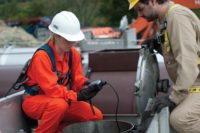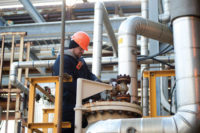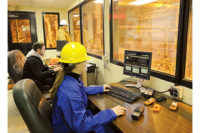
All gas sensors require routine testing and calibration.
Why?
The only way to ensure that a gas monitor will respond to the hazardous gas is to calibrate the sensor against a known gas standard. Whether your company employs portable or fixed-point gas monitor instrumentation, the fact that this equipment is a life-saving device can never be overlooked. If you don’t agree with this requirement, ask yourself if you would risk your life, or the life of one of your workers, by using a gas monitor that has not been tested or calibrated.
Testing is necessary
Gas monitoring equipment is typically exposed to some of the harshest and dirtiest workplace conditions. Gas sensors can easily become damaged or blocked by dirt and debris. If gas can’t diffuse into the sensor, the sensor will not respond to the gas. Visual inspection alone can’t detect blocked sensors; only function testing guarantees the detection of gas.
The safest approach to testing gas monitors is to function test or “bump” test them regularly by exposing each sensor in the gas monitor to a known concentration of gas in excess of the lowest alarm set-point. The monitor should respond to the gas concentration by going into alarm. If the sensors do not respond to the applied gas, calibrate the monitor before it is used.
Gas exposure is another field condition that can affect the frequency of required testing and calibration. Sensor damage can occur due to exposure to certain gases. These gases in either high or low concentrations could damage the electrodes or prevent the sensing elements from working properly. Calibration is needed to readjust the instrument’s accuracy after such an exposure occurs.
Gas monitor calibration is just as important as testing and consists of exposing the monitor’s sensors to a known concentration of gas and making appropriate adjustments to ensure the monitor is reading accurately. Typically, the instrument makes these adjustments automatically without user intervention. If the gas sensor fails calibration, replace it. Also, calibrate the new sensor after installation.
Testing and calibration are standard maintenance requirements for all gas monitors. They should not be taken lightly or ignored. A number of different regulatory agencies make recommendations for the frequency and methods of testing and calibration. All of these regulations and standards are put in place for one reason: worker safety. Protecting workers and preventing injury and death in the workplace should be the number one priority when establishing your testing and calibration procedures.
Then…a time-consuming task
More often than not, testing and calibrating fixed-point gas monitors has been overlooked or done less frequently than for portable monitors. Manually testing and calibrating every fixed monitor in a facility is a costly and time-consuming distraction from a company’s core business.
Currently, tests and calibrations are performed by a field technician who carries a cylinder of gas around to each fixed gas monitor within a facility. The monitors may be in hard-to-reach places requiring the technician to climb a ladder or maneuver over pipe racks to reach the monitors. These hazards only add to the risk of being in an area where deadly gas may be present. Once at the sensor, the technician must put the monitor into a calibration mode, and then apply gas manually.
These manual tasks result in unnecessary expenses and increased risk, and can jeopardize employee safety. With increased regulatory compliance and other higher priority issues, fewer resources are available to do the job right. Many times, less pressing requirements such as maintenance of gas monitors are delayed or overlooked. These and other obstacles make it difficult to follow industry best practices for routine testing and calibration.
Now…new testing tools
Over the last couple of years, automatic calibration stations and full function instrument management systems have made testing and calibrating portable monitors on schedule or on demand much easier. These tools have also increased equipment reliability, as well as safety within the workplace. Until now, however, these tools were only available for portable gas monitors.
Now, this technology has been adapted and made available for the remote testing and calibration of fixed-point monitors. Docking stations can now perform fixed monitor tests and calibrations automatically, or on demand remotely from a computer.
Either way, the need for a human being to manually perform these operations is eliminated. It is now possible to maintain and manage a fixed-point gas monitor fleet without leaving a desk. Companies can now perform hands-off maintenance and have a snapshot view of all data for their fixed gas monitor fleet in a centralized database.
Manual record-keeping is a thing of the past. On-demand retrieval of vital test or calibration data is a reality. Make no mistake, this information literally saves lives.
The advantages of this breakthrough are significant. Most importantly, fixed monitor users can now more easily follow industry best practices for routine testing and calibration. This will allow end-users to maintain their fixed-point monitor fleet more safely, efficiently and reliably with fewer burdens and associated costs. Routine testing and calibration of the equipment will ensure that the equipment continues to respond properly and accurately to gas exposures while providing a safe working environment.
Demand a safer workplace
Technological advances such as the ones mentioned in this article have aided many companies employing portable gas monitors in taking the necessary steps to creating a safer workplace for their employees. Suddenly, a workplace that is safer, more productive and more cost-effective is an attainable goal for fixed-point gas monitor customers as well.
As safety professionals continue to face the pressures of doing more with less, automated testing and calibration processes will continue to keep workers safe and allow companies to worry less about functions that are not core to their business. Technology has provided the proper tools to prevent workplace injuries and fatalities due to hazardous atmospheres.
It’s up to you to take advantage of these tools and demand a safer workplace.


